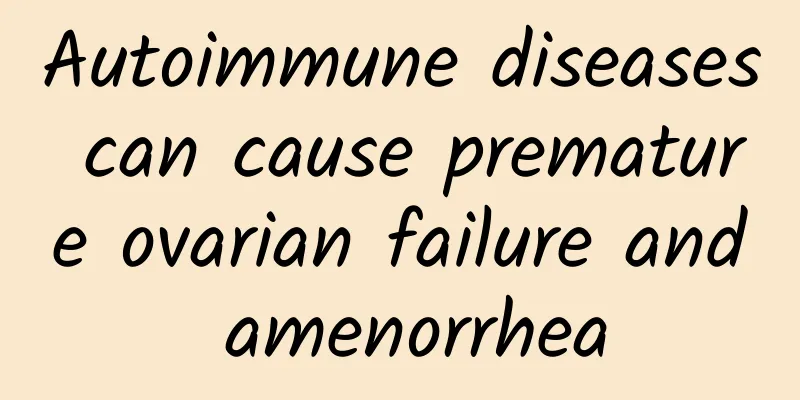Autoimmune diseases can cause premature ovarian failure and amenorrhea

|
Premature ovarian failure amenorrhea refers to secondary amenorrhea that occurs between the age of 35 and after menarche, and some argue that it occurs at any age between the age of 40 and is characterized by high gonadotropin and low estrogen, and ovarian histology shows changes in the perimenopause or postmenopause of elderly women. Patients with premature ovarian failure have unilateral gonadal dysgenesis. The first clinical manifestation is menstrual changes. Generally, after normal puberty sexual development, menstrual disorders or progressive oligomenorrhea appear, and then amenorrhea occurs. The typical symptoms of hot flashes and flushing are the only clues to the diagnosis. A variety of autoimmune diseases can cause premature ovarian failure. The most common is autoimmune thyroiditis, which is also seen in parathyroid/adrenalitis and polyglandular syndrome involving the above glands at the same time. Rare cases include myasthenia gravis, sudden thrombocytopenic purpura, rheumatoid arthritis, vitiligo and autoimmune hemolytic anemia. There are a variety of organ-specific autoimmune antibodies in the circulation, such as antibodies to the thyroid (anti-thyroglobulin and anti-microsomal antibodies), gastric parietal cells, adrenal cortex and parathyroid glands. It has been proven that these antibodies also act on follicular cells; a few reports only detected ovarian autoantibodies, but not other antibodies. Immunofluorescence showed that the antibody binds to the granulosa cells and theca cells of the follicles. It was also found that there are immunoglobulins in the serum that inhibit the binding of FSH (follicle stimulating hormone secreted by the pituitary gland) receptors. Lymphocyte infiltration in ovarian biopsy specimens is a histological feature of autoimmune oophoritis, and plasma cell nests may or may not be present; there are reports that the number of oocytes is reduced or absent due to the influence of autoimmunity, and occasionally the gonads are cord-like, with only interstitium and complete absence of primordial follicles. |
<<: Some obvious clinical symptoms of early vulvar leukoplakia
>>: Is it necessary to induce ovulation in adolescent functional uterine bleeding?
Recommend
What medicine is good for women with cervical erosion of degree 2? These methods can also treat cervical erosion of degree 2
The problem of cervical erosion is a big problem ...
Does premature menopause affect life expectancy?
Many patients do not understand the hazards of am...
What age do uterine fibroids usually occur? What age range do uterine fibroids occur?
What age do uterine fibroids usually occur? What ...
Is Leep Knife good for treating cervical erosion? It has a good effect
Leep knife has a good effect in treating cervical...
The most advanced method for diagnosing threatened miscarriage
In today's society, women are experiencing th...
What causes lower abdominal pain? Know these and understand your physical condition in time
Lower abdominal pain is something that many femal...
What is the best way to treat cervical erosion?
Cervical erosion, now more commonly known as cerv...
Why do I have my period twice a month?
Many women are confused and upset when they have ...
Treat insomnia and prevent functional uterine bleeding
Whether it is due to psychological factors such a...
What are the symptoms of habitual miscarriage? Pay special attention to these 4 symptoms
Nowadays, women are under great pressure in life....
There are many causes of cervical erosion.
Because the appearance of cervical erosion makes ...
Start preventing annoying menstrual cramps from small things
Menstruation is no stranger to every female frien...
What are the methods of self-abortion? Will it have any adverse effects on the body?
In many cases, people often need to do something ...
What to do with menstrual pain? Usually it is blood stasis
Menstrual pain is usually caused by blood stasis....
Is it normal for the right ovarian cyst to cause less and darker menstrual flow? What are the dangers?
Is it normal for the right ovarian cyst to cause ...









